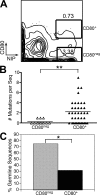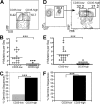New markers for murine memory B cells that define mutated and unmutated subsets
- PMID: 17698588
- PMCID: PMC2118690
- DOI: 10.1084/jem.20062571
New markers for murine memory B cells that define mutated and unmutated subsets
Abstract
The study of murine memory B cells has been limited by small cell numbers and the lack of a definitive marker. We have addressed some of these difficulties with hapten-specific transgenic (Tg) mouse models that yield relatively large numbers of antigen-specific memory B cells upon immunization. Using these models, along with a 5-bromo-2'-deoxyuridine (BrdU) pulse-label strategy, we compared memory cells to their naive precursors in a comprehensive flow cytometric survey, thus revealing several new murine memory B cell markers. Most interestingly, memory cells were phenotypically heterogeneous. Particularly surprising was the finding of an unmutated memory B cell subset identified by the expression of CD80 and CD35. We confirmed these findings in an analogous V region knock-in mouse and/or in non-Tg mice. There also was anatomic heterogeneity, with BrdU(+) memory cells residing not just in the marginal zone, as had been thought, but also in splenic follicles. These studies impact the current understanding of murine memory B cells by identifying new phenotypes and by challenging assumptions about the location and V region mutation status of memory cells. The apparent heterogeneity in the memory compartment implies either different origins and/or different functions, which we discuss.
Figures






References
-
- Ahmed, R., and D. Gray. 1996. Immunological memory and protective immunity: understanding their relation. Science. 272:54–60. - PubMed
-
- Bernasconi, N.L., E. Traggiai, and A. Lanzavecchia. 2002. Maintenance of serological memory by polyclonal activation of human memory B cells. Science. 298:2199–2202. - PubMed
-
- Dutton, R.W., L.M. Bradley, and S.L. Swain. 1998. T cell memory. Annu. Rev. Immunol. 16:201–223. - PubMed
-
- Tangye, S.G., D.T. Avery, E.K. Deenick, and P.D. Hodgkin. 2003. Intrinsic differences in the proliferation of naive and memory human B cells as a mechanism for enhanced secondary immune responses. J. Immunol. 170:686–694. - PubMed
-
- Agematsu, K., H. Nagumo, F.C. Yang, T. Nakazawa, K. Fukushima, S. Ito, K. Sugita, T. Mori, T. Kobata, C. Morimoto, and A. Komiyama. 1997. B cell subpopulations separated by CD27 and crucial collaboration of CD27+ B cells and helper T cells in immunoglobulin production. Eur. J. Immunol. 27:2073–2079. - PubMed
Publication types
MeSH terms
Substances
Grants and funding
LinkOut - more resources
Full Text Sources
Other Literature Sources
Miscellaneous

